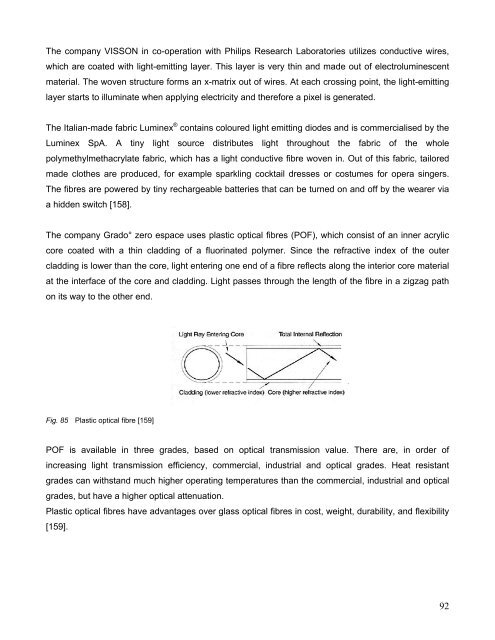Clevertex - Grado Zero Espace Srl
Clevertex - Grado Zero Espace Srl
Clevertex - Grado Zero Espace Srl
Create successful ePaper yourself
Turn your PDF publications into a flip-book with our unique Google optimized e-Paper software.
The company VISSON in co-operation with Philips Research Laboratories utilizes conductive wires,<br />
which are coated with light-emitting layer. This layer is very thin and made out of electroluminescent<br />
material. The woven structure forms an x-matrix out of wires. At each crossing point, the light-emitting<br />
layer starts to illuminate when applying electricity and therefore a pixel is generated.<br />
The Italian-made fabric Luminex ® contains coloured light emitting diodes and is commercialised by the<br />
Luminex SpA. A tiny light source distributes light throughout the fabric of the whole<br />
polymethylmethacrylate fabric, which has a light conductive fibre woven in. Out of this fabric, tailored<br />
made clothes are produced, for example sparkling cocktail dresses or costumes for opera singers.<br />
The fibres are powered by tiny rechargeable batteries that can be turned on and off by the wearer via<br />
a hidden switch [158].<br />
The company <strong>Grado</strong>° zero espace uses plastic optical fibres (POF), which consist of an inner acrylic<br />
core coated with a thin cladding of a fluorinated polymer. Since the refractive index of the outer<br />
cladding is lower than the core, light entering one end of a fibre reflects along the interior core material<br />
at the interface of the core and cladding. Light passes through the length of the fibre in a zigzag path<br />
on its way to the other end.<br />
Fig. 85 Plastic optical fibre [159]<br />
POF is available in three grades, based on optical transmission value. There are, in order of<br />
increasing light transmission efficiency, commercial, industrial and optical grades. Heat resistant<br />
grades can withstand much higher operating temperatures than the commercial, industrial and optical<br />
grades, but have a higher optical attenuation.<br />
Plastic optical fibres have advantages over glass optical fibres in cost, weight, durability, and flexibility<br />
[159].<br />
92

















